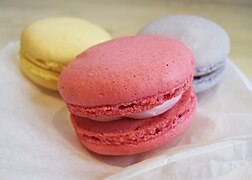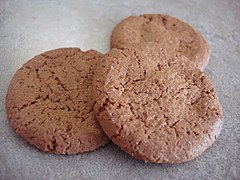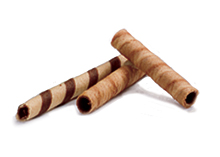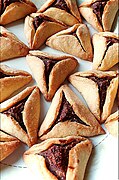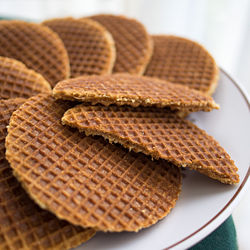Cookbook:Cookie
Cookbook | Recipes | Ingredients | Equipment | Techniques | Cookbook Disambiguation Pages
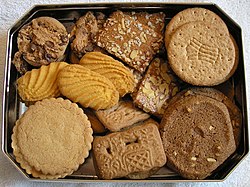
Cookies are a class of baked good, overlapping somewhat with cakes and pastries. The term "cookie" means "little cake", and it encompasses a wide variety of baked goods, including those called biscuits in British English.
Characteristics
[edit | edit source]Cookies can have a wide variety of characteristics—the main thing all cookies have in common is their overall small size and a tendency to be eaten with the hands. Otherwise, they come in a range of sizes, textures, shapes, flavors, and more.
Spread
[edit | edit source]The spread of a cookie refers to how much the dough spreads out horizontally during baking. High air content (from leavening or long creaming), high sugar content, high moisture, low oven temperature, and greased pans all contribute to increased cookie spread. High-protein flour, high gluten development, high temperature, low moisture, and cold dough all contribute to reduced overall spread. Butter will cause more spread than shortening because of the small amount of water present in butter. Confectioner's sugar will reduce spread compared to granulated sugar due to its moisture-absorbing starch content.
Chew
[edit | edit source]A variety of factors can contribute to a cookie's chewiness, including a high sugar-and-liquid to fat ratio, a high egg content, and a high-protein flour.
Crispness
[edit | edit source]The main cause of crispness in a cookie is very low moisture. This can be achieved by simply including little moisture in the initial dough, using high sugar and fat contents, baking for long enough to evaporate the moisture, and shaping the cookies thinly in order to more quickly achieve the latter.
Moisture
[edit | edit source]Cookies with a higher sugar content are generally moister than those without, as a result of sugar's hygroscopic properties. Eggs also contribute moisture.
Browning
[edit | edit source]Increased browning can be achieved, if desired, by longer time in the oven, higher oven temperature, and a higher-protein-content flour.
Leavening
[edit | edit source]Types
[edit | edit source]Rolled
[edit | edit source]Rolled or cut-out cookies are made by rolling out the dough into a thin sheet before cutting out individual cookies using a knife or cookie cutter.
Sliced
[edit | edit source]Sliced cookies, sometimes called icebox cookies, are made by shaping the dough into a log, chilling until firm, and slicing off individual cookies.
Drop
[edit | edit source]Drop or scoop cookies are made by portioning cookies directly onto the baking sheet using spoons or a scoop.
Molded
[edit | edit source]Molded cookies are made by shaping the cookie dough with a mold, stamp, or your hands.
Piped
[edit | edit source]Bar
[edit | edit source]Bar or sheet cookies are baked in one large sheet that is cut into individual pieces after baking. This can include brownies, pecan bars, some varieties of shortbread, and British flapjacks.
Tuile
[edit | edit source]Tuiles, unlike other cookies, are made with a batter instead of a dough. The batter is spread on a silicone baking mat before baking to yield a very thin, crisp cookie
Twice-baked
[edit | edit source]These cookies are made by baking a large mass of dough, slicing it into individual cookies, and baking a second time. This produces a very dry cookie and includes biscotti and mandelbrot.
Sandwich
[edit | edit source]Sandwich cookies are, as the name implies, made by sandwiching a filling between two cookies. These include macarons, oreos, alfajores, linzer cookies, and more.
Recipes
[edit | edit source]Gallery
[edit | edit source]-
Chocolate chip drop cookies
-
Macarons
-
Biscotti
-
Florentines
-
Alfajores
-
Pecan bars
-
Gingersnaps
-
Oreos
-
Stamping out cookies
-
The result of a cookie stamp
-
Fortune cookies
-
Langues de chat
-
Wafer cookies
-
Tuile cookies shaped into cigars
-
Macaroon
-
Animal crackers
-
Black-and-white cookies
-
Hamantaschen
-
Meringues
-
Russian teacakes
-
Stroopwafels
External links
[edit | edit source]- ↑ "Understanding the Science of Cookies | Institute of Culinary Education". www.ice.edu. Retrieved 2025-01-01.


